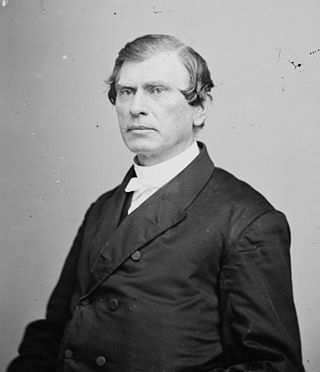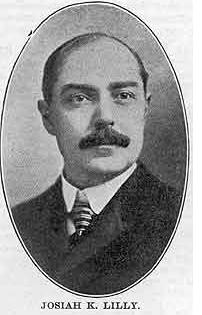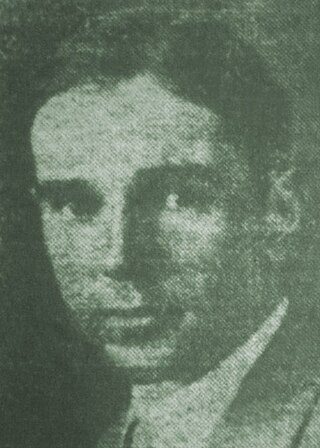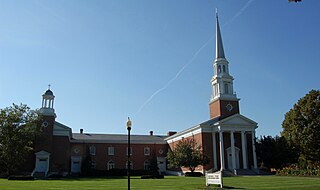
The University of Indianapolis (UIndy) is a private United Methodist Church-affiliated university in Indianapolis, Indiana. It offers Associate, Bachelor's, Master's, and Doctoral degrees. It was founded in 1902 as Indiana Central University and was popularly known as Indiana Central College from 1921 until 1975. In 1986 the name was changed to University of Indianapolis.

Matthew Simpson was an American bishop of the Methodist Episcopal Church, elected in 1852 and based mainly in Philadelphia. During the Reconstruction Era after the Civil War, most evangelical denominations in the North, especially the Methodists, were initially strong supporters of radical policies that favored the Freedmen and distrusted the Southern whites. However, by the late 1860s in border state conferences, the MEC North moved well away from their work with the Freedmen's Bureau and often sided with the grievances of Southern white members. Bishop Simpson played a leading role in mobilizing the Northern Methodists for the cause. His biographer calls him the "High Priest of the Radical Republicans."

Herron School of Art and Design, officially IU Herron School of Art and Design, is a public art school at Indiana University–Purdue University Indianapolis (IUPUI) in Indianapolis, Indiana. It is a professional art school and has been accredited by the National Association of Schools of Art and Design since 1952.

The Stephen Collins Foster Memorial is a performing arts center and museum which houses the Stephen Foster Archives at the University of Pittsburgh in Pittsburgh, Pennsylvania, USA. It is dedicated to the life and works of American songwriter Stephen Foster.

Josiah Kirby Lilly Sr., nicknamed "J. K.," was an American businessman, pharmaceutical industrialist, and philanthropist who became president and chairman of the board of Eli Lilly and Company, the pharmaceutical firm his father, Colonel Eli Lilly, founded in 1876. Josiah, the colonel's sole heir, began working at his father’s company at the age of fourteen. He graduated from the Philadelphia College of Pharmacy and Science and became superintendent of the Lilly laboratories in 1882 and company president in 1898. Under his leadership, the company introduced standardized manufacturing processes, expanded its sales force, and increased its research efforts to develop new drugs. Eli Lilly and Company grew into one of the largest and most influential pharmaceutical corporations in the world, and the largest corporation in Indiana. Lilly’s eldest son, Eli Jr., succeeded him as president in 1932. His younger son, Josiah Jr. ("Joe"), succeeded Eli as company president in 1948. J. K. served as chairman of the board from 1932 until his death in 1948.

Walker and Weeks was an architecture firm based in Cleveland, Ohio, founded by Frank Ray Walker and Harry E. Weeks.
Fletcher Hodges Jr. was an American who curated the Foster Hall Collection, a collection of documents and music related to Stephen Foster at the University of Pittsburgh, for fifty-one years.
The Rev. Titus Lowe was an English-American bishop of the Methodist Episcopal Church and The Methodist Church, elected in 1924.

Powers Hapgood (1899–1949) was an American trade union organizer and Socialist Party leader known for his involvement with the United Mine Workers in the 1920s.

Andrew Wylie was an American academic and theologian, who was president of Jefferson College (1811–1816) and Washington College (1816–1828) before becoming the first president of Indiana University (1829–1851).
Herman C. Krannert (1887–1972) was a businessman and philanthropist in the Midwest of the United States who made millions in the corrugated fiber products industry and subsequently made generous contributions to education and the arts. Among other substantial contributions, eleven buildings bear the Krannert name, most of them at hospitals and universities in Illinois and Indiana, including the Krannert School of Management at Purdue University, and the Krannert Art Museum and Krannert Center for the Performing Arts at the University of Illinois at Urbana-Champaign.
Joseph Thomas Taylor was an American academic, educator and activist who was named dean of Indiana University at the downtown Indianapolis Campus on February 24, 1967. In 1972, he became the first dean of the newly created School of Liberal Arts at Indiana University – Purdue University Indianapolis (IUPUI). He was married to Hertha Ward-Taylor and they had three children: deceased actor Meshach Taylor, Judith F. Taylor and Hussain Taylor.

Bohlen, Meyer, Gibson and Associates, or BMG, is an architectural firm based in Indianapolis, Indiana. It was founded in Indianapolis on April 10, 1853, as D. A. Bohlen, Architect by Diedrich A. Bohlen, German immigrant. In 1884, after Diedrich's son, Oscar D. Bohlen, joined the firm it was renamed D. A. Bohlen and Son. Four successive generations of Bohlen architects have worked at the firm: Diedrich A. Bohlen, Oscar D. Bohlen, August C. Bohlen, and Robert L. Bohlen. The firm specialized in institutional projects, especially civic, religious, and educational buildings. In 1971 Melvin B. G. Meyer acquired majority interest in the firm, which adopted its name in reference to its founder and its two principal architects, Meyer and John M. Gibson. The architectural firm is among the oldest still operating in the United States. More than twenty of its projects are listed on the National Register of Historic Places.
Ralph Basui Watkins is the Peachtree Associate Professor of Evangelism and Church Growth at Columbia Theological Seminary, in Decatur, Georgia, United States. He also serves as the senior pastor of the historic Wheat Street Baptist Church in Atlanta, Georgia, United States.
Sarah B. Cochran was an active philanthropist and a director on multiple corporate boards in western Pennsylvania during the height of the area's coal wealth in the early 20th century. At one time, she was one of the wealthiest women on the East Coast. She was the first female trustee of Allegheny College and financed construction of Linden Hall and the Philip G. Cochran Memorial United Methodist Church, both on the National Register of Historic Places.

Meridian Street United Methodist Church, known in its early years as Wesley Chapel, the Meridian Street Methodist Episcopal Church, and the Meridian Street Methodist Church, is a Methodist church located at 5500 North Meridian Street in Indianapolis, Indiana. The church originated from the first Methodist congregation in Indianapolis that began in a log cabin in 1821–22 with fifty members. The congregation worshipped at several locations and erected four earlier churches on Monument Circle and along Meridian Street in downtown Indianapolis before it merged with the Fifty-first Street Methodists in 1945. The first service at its North Meridian Street location was held on June 29, 1952. Designed by the architectural firm of Russ and Harrison, the Georgian-Colonial-style, red-brick church is noted for its architecture, pipe organ, and formal parlor. The Aldersgate addition on the west side (rear) of the church was consecrated on October 4, 1989.









